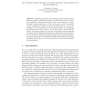Free Online Productivity Tools
i2Speak
i2Symbol
i2OCR
iTex2Img
iWeb2Print
iWeb2Shot
i2Type
iPdf2Split
iPdf2Merge
i2Bopomofo
i2Arabic
i2Style
i2Image
i2PDF
iLatex2Rtf
Sci2ools
SG
2005
Springer
2005
Springer
Virtual Camera Planning: A Survey
Modelling, animation and rendering has dominated research computer graphics yielding increasingly rich and realistic virtual worlds. The complexity, richness and quality of the virtual worlds are viewed through a single media that is a virtual camera. In order to properly convey information, whether related to the characters in a scene, the aesthetics of the composition or the emotional impact of the lighting, particular attention must be given to how the camera is positioned and moved. This paper presents an overview of automated camera planning techniques. After analyzing the requirements with respect to shot properties, we review the solution techniques and present a broad classification of existing approaches. We identify the principal shortcomings of existing techniques and propose a set of objectives for research into automated camera planning.
| Added | 28 Jun 2010 |
| Updated | 28 Jun 2010 |
| Type | Conference |
| Year | 2005 |
| Where | SG |
| Authors | Marc Christie, Rumesh Machap, Jean-Marie Normand, Patrick Olivier, Jonathan Pickering |
Comments (0)

